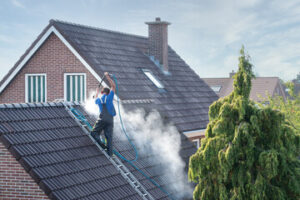A dirty roof isn’t just ugly, it can actually decrease the life of your shingles or other roofing materials. It can also increase your energy costs due to poor reflectivity.

Thankfully, roof cleaning can solve these issues by removing the algae, moss, mildew and other growths that degrade the surface. The cleaning process involves a variety of techniques including soft washing and chemical treatments. Contact Roof Cleaning Summerville SC for professional help.
Debris that gathers on a roof can damage the surface, encourage pests and cause problems such as clogged gutters. Regular maintenance is important to remove this debris. It also helps prevent problems by reducing the number of areas in which pests can nest and water collects.
If you decide to do the work yourself, be sure to use a sturdy ladder and wear a pair of rubber gloves to protect your hands. You will also need a broom and a garden hose to wash away small particles. A good day to clear the roof is when it is dry and not windy.
You will need to start by removing large branches, leaves and other debris from the surface of the roof. A soft bristle broom will work well for this, although it’s always best to avoid scraping the shingles as this can cause them to become loose and vulnerable to water penetration.
Once the larger debris is removed, you can focus on removing moss or algae growth. Usually, chlorine bleach (the kind used to whiten laundry) and water will kill and remove any moss or algae spores. It is recommended to use a hose with low pressure and to avoid spraying the shingles as this can damage them.
Once all the moss or algae is dead and washed away, it’s time to clean the rest of the roof. Again, a soft bristle broom should be used and the hose again can be rinsed with a low pressure to remove any remaining dirt, debris or cleaning solution.
Using a blower to remove the debris will also push it into the gutters, which will need to be cleared as well. Using a gutter vacuum, or simply scooping the debris into buckets and garbage bags will help minimize spreading the debris around your home. It’s also a great way to see any damage that might need to be repaired, such as holes in the shingles, which should be fixed by a professional right away.
Detergent or Bleach Solution
Using a detergent or bleach solution to clean your roof is one of the best ways to kill the algae, moss and mildew that are growing on your shingles. Most professionals use a 3% bleach solution to get the job done, and some also add a surfactant such as Sticky to help their solution cling to surfaces and dwell longer. Bleach is very effective in killing all types of spores and should not void your roof’s warranty when used according to manufacturer instructions.
It is important to remember that if you decide to use a bleach solution, you must wear rubber gloves and goggles to protect yourself from the harsh fumes. You must also carefully follow the manufacturer’s recommendations to ensure that you are not causing any damage to your roof or surrounding landscaping.
Depending on the condition of your roof, you may need to rinse the surface after spraying and allow it to dry completely. Then, you will need to take preventative measures to keep your roof healthy and free from debris, moss, mildew, and algae. This includes trimming overhanging tree branches that can block sunlight and promote moss and algae growth. It is also a good idea to clean your roof regularly to prevent buildup of grime, especially in moisture-heavy climates.
For those who would rather avoid bleach or other harsh chemicals, there are many products available that kill spores without requiring excessive dwell time or abrasive pressure. Examples of these products include percarbonate cleaners and hydrogen peroxide, but they are not as effective as the bleach-based solutions.
Regardless of what product you choose, it is always recommended to choose a cloudy day for roof cleaning. This way the solution can stay on your roof longer and it will not be affected by any wind or precipitation. Ideally, you will want to clean your roof every 2-5 years depending on the climate you live in and how much sun your roof gets. Keeping your roof regularly cleaned can help you extend the life of your roof and save you the hassle and expense of having to replace it sooner.
Power Washing
It is important to remember that when cleaning a roof, you must never use a power washer. This is because using a power washer can damage the surface of your roof, and the water pressure can also enter through any cracks or holes that may be in the surface of your roof, potentially causing serious and costly leaks into your home.
When cleaning a roof, it is generally best to use a soft wash technique instead of pressure washing. This is because the soft wash technique will help to kill and remove any algae, moss, mildew, or dirt that has built up on your roof, without damaging the surface of your roof. The soft wash technique is also a good way to avoid any potential hazards that can be caused by pressure washing your roof, such as falling debris and damage to your gutters.
To do a soft wash on your roof, you will start by spraying the area of your roof that needs to be cleaned with a biodegradable detergent solution. The detergent will loosen the grime on the surface of your roof, and it will also help to kill any mold or fungus that is growing on your roof. Once the detergent has had time to work on your roof, you will rinse it off with clean water. This will leave your roof clean, and it will also look new and refreshed.
You can also try to clean your roof by scrubbing the dirt and debris off of it with a brush, if needed. However, if your roof is severely stained or covered with moss and other growths, then you will likely need to hire a professional that offers roof cleaning services.
When hiring a professional to clean your roof, be sure to ask about their method of soft washing. A reputable and experienced roof cleaner will be able to clean your roof safely and effectively, and they will know how to avoid any potential risks and hazards that can come along with using a pressure washer. They will also know how to clean your roof quickly, so that it is done as soon as possible and can return to providing you with shelter and protection.
Drying
This is a very important step when cleaning your roof. The water from the washing must evaporate completely to prevent damage to your shingles, which can lead to leaks or further deterioration of the roof. This drying process can be expedited if you are located in a warmer, drier climate as the sun’s heat will help the water to evaporate more quickly.
After the cleaning process is complete, your home’s gutters should be inspected and cleaned to ensure that all of the debris has been removed from the gutter system. It is also recommended that the homeowner take this opportunity to inspect the condition of their roof for any potential damage or wear and tear that may need repair. If you have any damaged or cracked shingles, it is recommended that you schedule a professional to perform repairs.
Algae stains and moss on your roof can be unsightly and harmful to your home’s structure and it is imperative to get them cleaned. These organic growths develop communities of bacteria / funguses that cause damage to your roof and shorten its lifespan. These organisms thrive in areas that are dark and do not receive a lot of sunlight.
Chemicals are used to kill the algae and moss during the roof cleaning process. Chlorine bleach, the same kind of bleach that is used to whiten clothes and scrub toilets, is usually sufficient to kill these organisms. It is also recommended that a non-chlorine, bleach-based cleaner be used for cedar shake and shingle roofs as the chlorine in regular household bleach can eat through these types of roofing materials.
In addition, using a non-chlorine based cleaner will eliminate any risk of damaging the plants and trees surrounding your home as chlorine can be toxic to certain vegetation. It is important to protect any vegetation surrounding your home during the cleaning process by either covering it with plastic or securing it with metal tarps. If you live in an area with a lot of trees, it is a good idea to consult your local arborist for recommendations on protecting your trees and shrubbery during this time.

